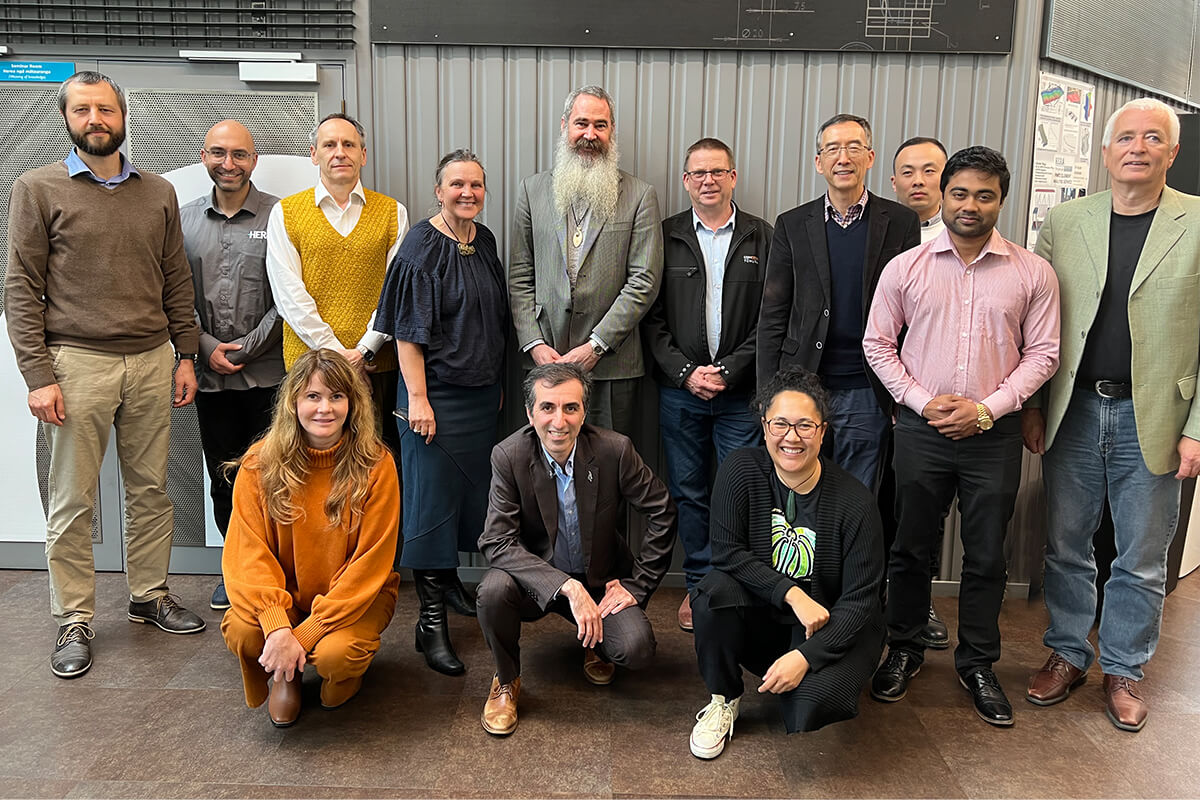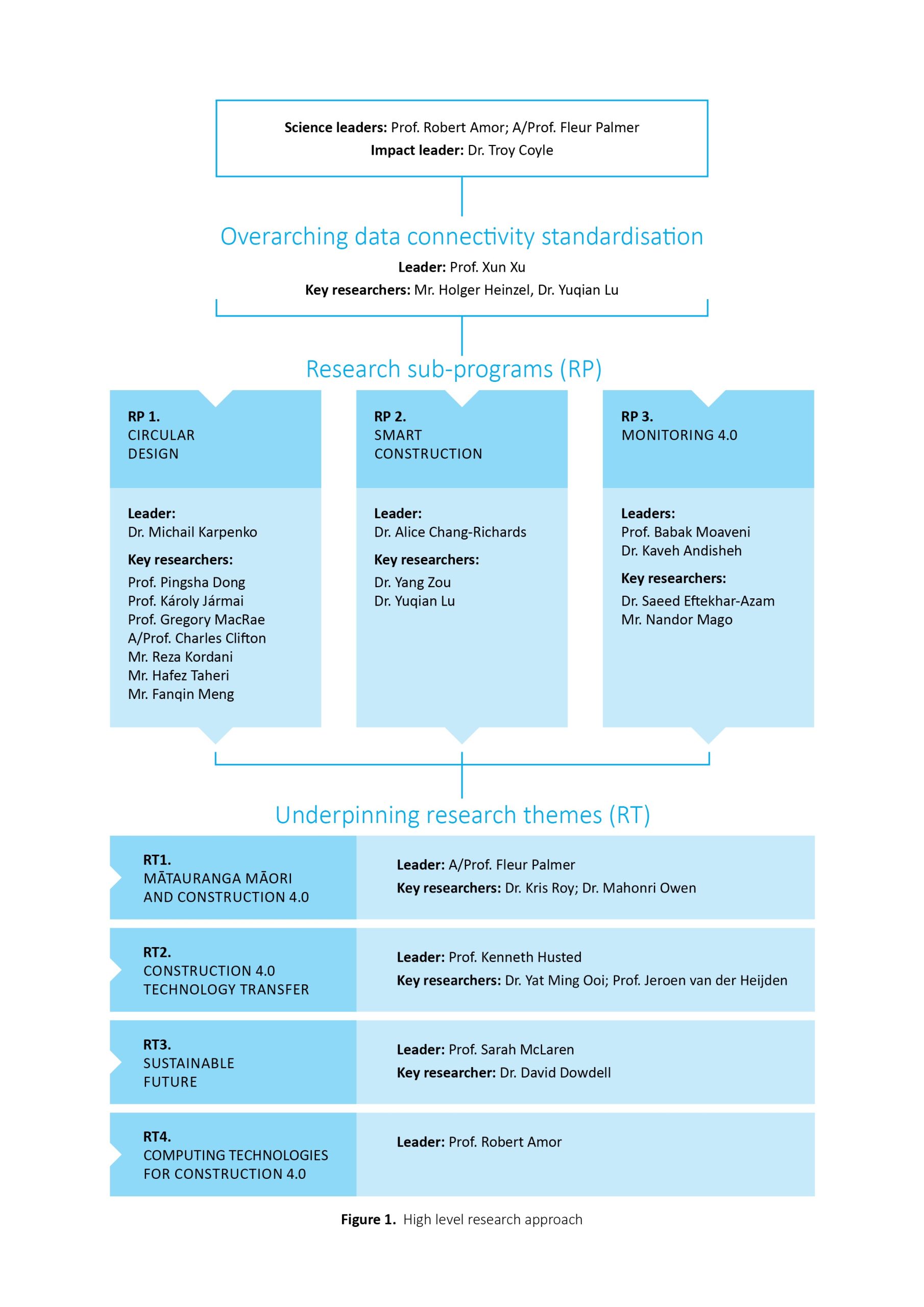Just recently we had our kick-off meeting with the Construction 4.0 team at HERA House – joined of course, by many of our team across the motu and overseas.
It was such a great day for the team of connection and re-connection. So, in this week’s Construction 4.0 report, I am going to focus on the people who are part of this massive project.
We have representatives from nine Universities. These include Auckland University of Technology, Massey University, Tufts University, University of Canterbury, University of Michigan, University of Miskolc, University of New Hampshire, University of Auckland and University of Waikato. BRANZ is also involved, as well as Prof. Jeroen va der Heijden.
In summary, the team comprises:
Data connectivity standardisation
Led by Professor Xun Xu, Head of Laboratory for Industry 4.0 Smart Manufacturing Systems, University of Auckland, NZ’s first Industry 4.0 Lab. He leads one of the top research teams in the world in the areas of smart manufacturing, cloud manufacturing, and product data representation. Xun is supported by Holger Heinzel, Fabrication 4.0 expert, and Dr. Yuqian Lu, industrial IoT and AI expert.
RP1.
Circular design
Led by Dr Michail Karpenko, GM of Fabrication 4.0, HERA, is NZ’s leading researcher in advanced connection design and analysis. Michail established NZ’s first Fabrication 4.0 lab. He is supported by a team including Professor Pingsha Dong, University of Michigan (USA), who is an international leader in advanced design and analysis methodologies for engineering structures, including design optimisation.
RP2.
Smart construction
Led by Dr Alice Chang-Richards, Senior Lecturer, University of Auckland. Alice is a leading specialist in construction technology, systems analysis and computational modelling for decision-support and is part of an existing BRANZ funded project investigating the potential limitations of Construction 4.0 in NZ. She is supported by Dr Yang Zou, construction informatics and digitisation expert, and Dr. Yuqian Lu, expert in construction process automation.
RP3.
Monitoring 4.0
Led by Professor Babak Moaveni, Department of Civil and Environmental Engineering, Tufts University (USA); and by Dr. Kaveh Andisheh GM of Structural Systems, HERA. Babak has extensive experience in instrumentation, structural health monitoring and performance assessment of structures. Kaveh is a multi-committee member of joint Australia and New Zealand (AS/NZS) and New Zealand (SNZ) Standards. They are supported by Dr. Saeed Eftekhar-Azam, Assistant Professor, University of New Hampshire (USA), who is expert in Bayesian system identification methods for structural health monitoring.
RT1.
Mātauranga Māori
Led by A/Prof Fleur Palmer, Associate Professor of Architecture and Future Environments at Auckland University of Technology, Co-Head Huri te Ao Hoahoanga. She is supported by Dr. Mahonri Owen and Dr. Kris Roy at University of Waikato.
RT2.
Construction 4.0 technology transfer
Led by Prof Kenneth Husted, the University of Auckland. He is an international leader in research focused on knowledge sharing in and between organisations and science/industry collaboration. He is supported by Dr Yat Ming Ooi, who is expert in knowledge flows from engineering to industry; and by Prof Jeroen van der Heijden, Chair in Regulatory Practice, School of Government, Victoria University of Wellington, who is an expert in public policy development and implementation.
RT3.
Building a sustainable future
Led by Professor Sarah McLaren, Director of NZ Life Cycle Management Centre and expert in the relationship between LCA and decision-support. She is supported by Dr David Dowdell, Principal Scientist, BRANZ, Science Lead for the BRANZ “Transition to a Zero Carbon Built Environment” project. David developed NZ’s whole-building, whole-of-life framework and accompanying design-support tools.
RT4.
Computing technologies for construction 4.0
Led by Professor Robert Amor, University of Auckland. He is an expert in interoperability and integrated environments. Since 2003 he has coordinated CIB’s working group W78 (IT for Construction). He is also theme leader for digital innovation in the MBIE-funded Building Innovation Partnership.
An impressive team for an ambitious program
We were very excited to pull our team together and the Endeavour Funding assessors were too! Here are some of the pieces of feedback that they gave:
“The project team is equipped with leading researchers who are perfectly capable of accomplishing the proposed research activities within their individual project modules. The project has great potentials in generating new knowledge.”
“Treaty based structure and Whare korero methodology has potential to demystify relevance of Mātauranga Māori. Alignment with whare tapawhā; taha tinana; taha wairua; taha hinengaro and taha whānau will introduce improvements that impact all spheres of the work environment. Latent potential of Mātauranga Māori can be realised in this project.”
“The comprehensiveness of the project, trending research themes, considering possible benefits and values, a large team of senior experts, diverse with strong background, and high involvement of Māori experts.”
“This is a large research programme that will involve many senior researchers in digital design and construction. Construction 4.0 transformation will bring in a lot of benefits such as the improvement of productivity, upskill, etc. There will be international collaboration that will facilitate learning from overseas practices.”
When we all met on Friday, we found so much enthusiasm and alignment for our shared research program. We are challenging ourselves completely on how we do things- including a focus on Industry 4.0 in how we manage the project and inclusion of cultural competency training for us all so that we can really start transformation of the sector.
We are all keen to start with Te Tiriti o Waitangi training and the enthusiasm grew to include next steps of a two day Wānanga with lots of training on tikanga, kawa and te reo Māori, hopefully with a pure ceremony to start us off with the right intentions. It was such a pleasure to start the process with a real focus on whakawhanaungatanga (relationship building) as we build our Construction4.0 research family.
We also agreed to start our communications immediately, so we are in the process of building a Construction4.0hub where everyone working in this area can add and share content. As part of this commitment, we have launched our LinkedIn page to get the communications ball rolling – it would be great if all HERA members join the Construction4.0 whanau!
Join us on LinkedIn: https://www.linkedin.com/showcase/89558522/admin/.


